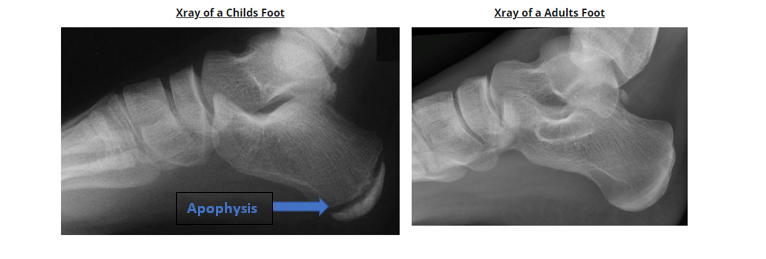25 Aug Severs Disease

Heel pain or Severs disease is common in athletic youth especially aged 8-15, with girls typically getting it slightly earlier than boys. Boys tend to be more common, mainly because overall they tend to be more physically active.
To understand Severs and its management you need to understand a little about growth and development. When we are born we need the ability to grow. To do this there are small gaps in various places in the bones. These are the growth plates (apophysis). As you grow the growth plates are the centre from where new bone grows. As you mature and reach your adult size these plates close – see pictures above.
Growth plates close at different stages of development. The ones on the heel shown above close at approximately age 15 for boys, and slightly earlier for girls, as their growth typically occurs slightly earlier.
From about 8 through to 12 years most children start their largest growth spurt since they were a baby. The age they start this can vary considerably, but it is when your child suddenly shoots up in height. At this time bone is being laid down at a great rate causing the growth. Unfortunately, the muscles and tendon can’t adapt as quickly and this leads to a reduced flexibility, and often a short period of time where athletes become relatively uncoordinated compared to normal.
In most, the body accommodates to this in time as the muscles and tendons catch up. However, in some athletes, especially those doing a lot of sport and physical activity, it is a time where problems arise.
The achilles tendon attaches onto the heel bone (calcaneus) on the small side of the growth plate. The growth plate is not as strong as the surrounding bone, so the pull from the tightness in the calf muscles along with high levels of sport and physical activity overload the area. This results in pain and often swelling in the heel region.
Symptoms will typically include stiffness and soreness getting out of bed which warms up with mild activity but gets sore again with physical activity, especially if involving lots of running or activity on harder surfaces. The level of symptoms can range from a mild discomfort to a limiting pain.
The timing of the growth spurt often corresponds to times where athletes are becoming more serious in their sports , or perhaps starting age group teams as well as playing for their school or club. This results in higher levels of physical activity at a time where the body is less able to cope with the load.
So what can be done.
Prevention – though it is not possible to 100% prevent the chances of getting Severs there are some things that may help. Firstly, exercises to both strengthen and improve the flexibility of the calf muscles before the growth spurt will help them cope with these changes. If a muscle is stronger to start with then it will cope with load better and not have to work as hard. This results in less stress in the region. Though they will lose flexibility as they grow, if they have poor flexibility to begin with, they won’t cope as well. Finally, if you note that they are shooting up, and they are very active, reduce the overall activity or intensity that they undertake until the growth spurt stops. This will probably prove the most difficult to convince them to do.
Management – If they start to mention heel pain, or you notice they are limping or favouring things in the mornings or during or after physical activity, get them seen by a physiotherapist straight away. Treatment will often involve stretches and possibly strengthening work, but it will have some sort of activity modification / reduction. Ice or pain relief may help in more severe cases. The ‘golden rule’ we tend to work to is, if they are not limping, they can continue, but if they are limping, they need to back off until they can move comfortably without a limp. However, everyone needs individual management.
Generally this is self-limiting, and it will resolve when the bone matures and the growth plate closes. However, if they haven’t managed things well, the area often becomes permanently swollen and thickened and could cause issues at a later date.


Sorry, the comment form is closed at this time.